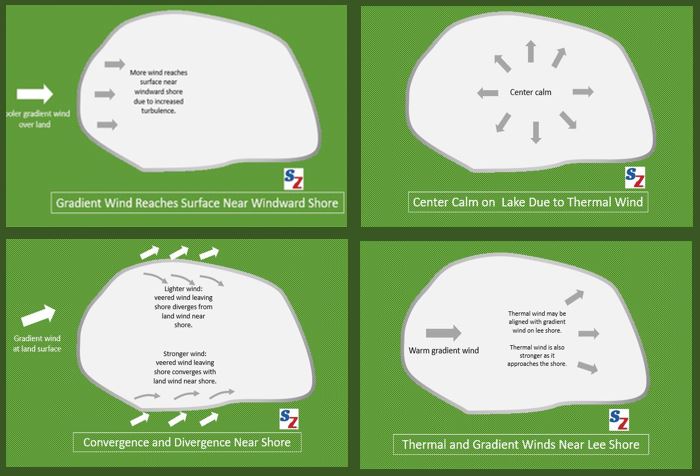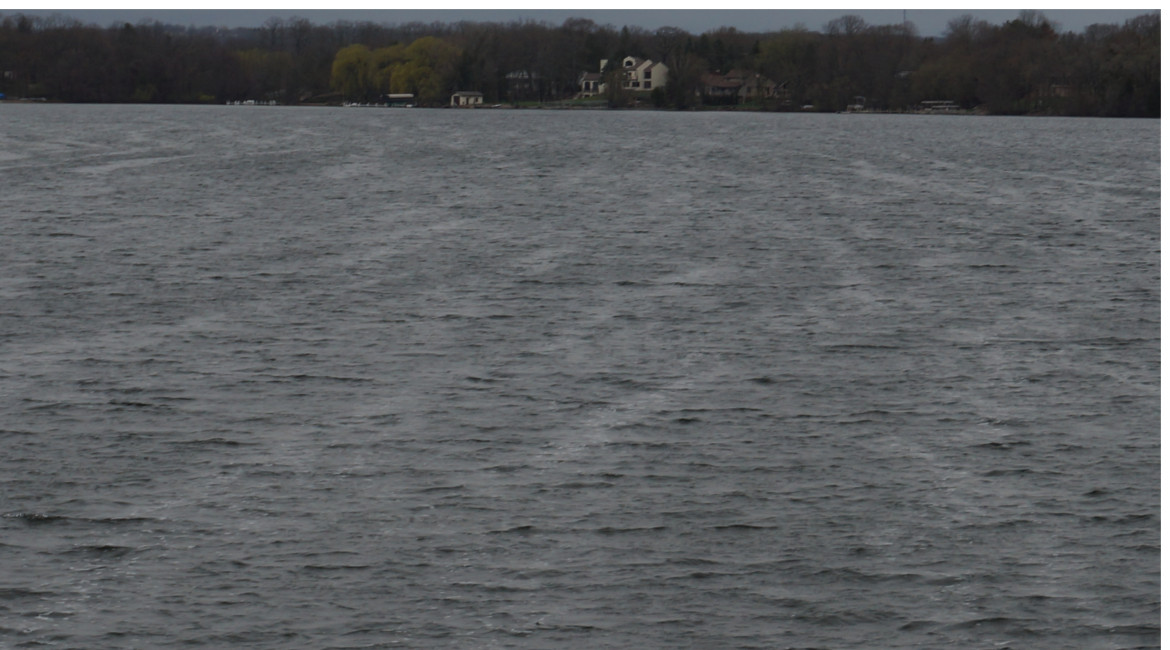When I was starting out racing on our tiny lake, a mentor told me to look for more wind near the shore in light air. This appeared to be true frequently, but as with many rules of thumb in sailing, it didn’t always work and I forgot about it. As a result, I got stung badly in a recent light air race.
Why is there often more wind near the shore in light air? We decided to dig into the dense explanations of wind for sailors to find out. We consulted The Sailor’s Wind, by Stuart Walker, and Wind Strategy, by David Houghton and Fiona Campbell.
This post has been updated to add clarity and correct some misleading statements. Thanks to Chelsea Carlson of Sea Tactics for pointing out areas for improvement.
Wind – The Basics
Most sailors understand the basics of wind, but for completeness we’ll cover parts of it very briefly here. For more, read Houghton and Campbell’s excellent and easy to follow book.
Gradient and Thermal Winds
The wind at the lake’s surface depends on the interaction between the area’s gradient wind and any thermal winds that may or may not exist. It is useful to understand some key points about gradient and thermal winds.
- The gradient wind results from atmospheric pressure differences over a large area. The gradient wind at the surface will be in roughly the same direction as the wind at several hundred feet or more above the surface. However, in very light air, the gradient wind at the surface will be weaker due to surface friction and the lack of turbulent mixing.
- Thermal winds are driven by localized temperature differences between the land and water, or between adjacent waters, such as a river and lake. Thermal winds circulate: the wind at the surface will be in a different direction than the wind at the top of the circulation. In a typical developing lake or sea breeze, the wind at the surface will flow from the water to the shore (onshore) and the wind at height will flow from the land to the water (offshore).
- Lakes smaller than a few miles across do not easily support significant thermal winds. This is because small lakes don’t have enough surface area, and thus enough air overhead to support sustained circulation. Thus, small lakes typically see mostly gradient wind, altered by shore effects.
Drag Affects Speed and Direction
As the gradient wind descends to the surface through mixing, it slows down due to friction (drag) with the surface. When it slows down, it also changes direction due to the effects of the earth’s rotation.
Since water is smoother than land, the wind’s speed and direction change as it leaves the shore. It accelerates due to reduced friction. As it accelerates, it bends to the right (veers) in the northern hemisphere. Here’s a nice video showing why hurricanes always spin counterclockwise in the northern hemisphere. This is the same reason the wind veers right as it accelerates.
Wind Near the Shore in Light Air – Theory
Near the shore, the wind will be affected by the gradient wind, the thermal wind (if present), mixing effects, and drag effects. Let’s look at the theory regarding the interaction of these effects in light air.
Thermal winds are stronger near the shore
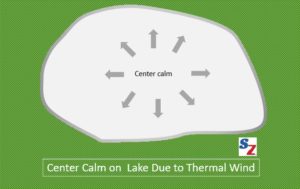
If the land is warmer than the water, it heats the air. The heated air rises, pulling cooler air from the surface of the water toward shore to replace it. If the thermal effect occurs all around the shore, it will pull air from the lake in all directions, leaving the center of the lake calm. The thermal wind also accelerates as it gets closer to the shore.
Gradient wind near the windward shore – turbulence and obstructions
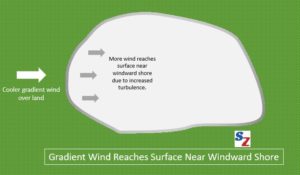
In light air, there is less turbulence to bring the gradient wind to the surface. Near the windward shore, however, the gradient wind picks up turbulence from the rough land below. This turbulence may be enough to bring the wind to the surface near the windward shore, resulting in stronger wind. The wind would then lift off the surface further out in the lake as turbulence dies away. This effect is stronger if the gradient wind is cooler than the surface.
However, tall obstacles on the windward shore may prevent the wind from reaching the surface. Houghton’s book has a graph that shows the effect of obstacles. Their “shadow” extends into the lake anywhere from 10 – 30 times their height, depending speed of the wind and on the density of the barrier.
Here’s a video for kitesurfers on the effects of obstacles showing some striking visuals. One caution about the video’s use of the term “gradient wind.” The author uses the terms “gradient wind” and “wind gradient” interchangeably, even though they are completely different terms. “Wind gradient” refers to the difference in the wind’s speed with height above the surface. “Gradient wind” refers to the wind caused by atmospheric pressure differences over large areas.
Parallel Shores – Convergence and Divergence
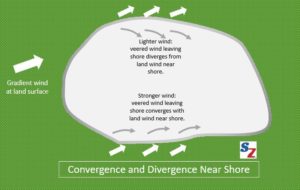
On the shores parallel to the course, the wind may be stronger on the left shore (looking upwind) than on the right. This is because the wind turns right (veers) as it leaves the shore.
- On the left hand shore, the wind veers and converges with the wind on the shore, making it stronger.
- On the right hand shore, the wind veers and diverges from the wind on the shore, making an area where the wind is weaker.
Convergence and divergence depend on many factors, and may only occur under just the right conditions. Convergence is rarer in small lakes.
Gradient and Thermal Wind Interaction
On the windward shore, the thermal wind and the gradient wind are blowing in the same direction at height. At the windward shore, the gradient wind will reinforce the offshore component of the thermal wind. Therefore, the wind may be stronger at the windward shore. See our post, “The Three Dimensions of a Lake Breeze” for more on this.
Light Air Strategy – Five Tips
Everything you read about light air strategy advises you to avoid the middle and seek more wind on one side of the course. If the course layout puts a shore near one of the sides, that may be the favored side. Here are five light air strategy tips, adapted from Walker’s The Sailor’s Wind and Advanced Racing Tactics.
#1. Pick a Side
- Get to the course early and look for recurring differences in wind strength across the course.
- Also look for other indicators of differences, including clouds, smoke, flags, etc.
- Continually observe these differences until the start.
- If in doubt, pick the side nearest the shore. This is especially true if the next mark is near a shore. There will often be an advantaged zone close to, but not right at the shore.
#2. Go to the chosen side until you reach the advantaged zone
- Sail fast to the advantage. The first boats to reach it will get the lead.
- Don’t lose confidence and bail out early. You may end up in no-man’s land.
#3. Stay in the advantaged zone as long as possible
- If on a lift, tack away early if you are leaving the zone.
- Hold headers longer to stay in the zone.
- You may even want to overstand the layline if needed to stay in stronger wind.
#4. In the zone, use shifts, rather than chase puffs
- Puffs and lulls will be random and change quickly. Chasing them will be futile.
- Use shifts to shorten your distance sailed. Tack on headers, stay on lifts.
#5. Cross the middle only if you have to
- Often, either side of the course is better than the middle in light air
- Cross only when certain that the advantage on the other side is real and permanent
- Make the shortest or fastest crossing possible
- Early or late in the leg when the crossing is narrowest
- Find some better than average velocity or direction to cross on
- Never cross the middle more than once.
Right or Left? How to Choose the Faster Side – Gary Jobson, in Sailing World
Stay with the Wind you Have – Stuart Walker, in Sailing World
Strategic Priorities in Light Air and Breeze – Speed and Smarts
Wind Strategy (Houghton and Campbell): Best Wind Book for Sailors – SailZing book review

